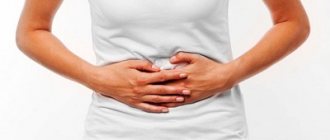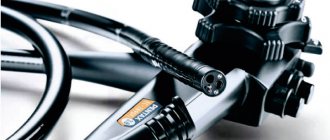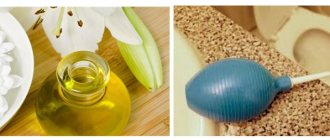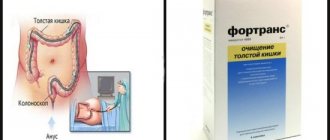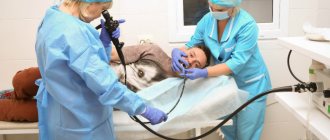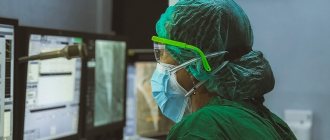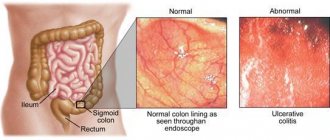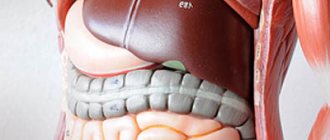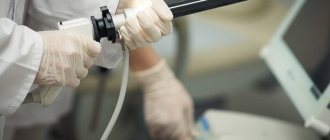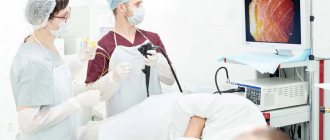Sigmoidoscopy is one of the most common methods of examining the body. Preparation for the procedure should consist of two stages: a special diet and subsequent cleansing. To carry out the latter, you need a maximally mobile intestine, without retained fibers from food, undigested residues, etc. This is achieved by diet.
Features of sigmoidoscopy
In the presence of intestinal pathologies, the correct conclusion can be made only by resorting to instrumental diagnostic methods. One of the most popular techniques is the procedure for examining the inner surface of the intestine.
Sigmoidoscopy (rectoscopy) is an endoscopic examination of parts of the intestine located at a distance of up to 35 cm from the anus. A visual inspection is done using a sigmoidoscope. This method is used as a mandatory element of a proctological examination. Patients who have reached the age of 40 are recommended to undergo annual examinations.
During this manipulation, the following options appear:
- detection of malignant neoplasms;
- assessment of the intestinal walls for their elasticity, muscle tone and features of the vascular pattern.
Even microscopic neoplasms that are not detected by other methods can be detected with its help.
Order of conduct
Before performing anoscopy, the doctor examines the patient (palpation). During the study, an anoscope is used - a metal or plastic medical instrument with a built-in optical device for visual analysis. It has a smooth surface, devoid of traumatic elements. Its diameter is up to 1 cm.
At the beginning of the procedure, a preliminary examination is provided:
- The patient takes a comfortable position in a chair or on a special couch.
- The doctor's gloves are lubricated with a lubricant in the form of a gel or ointment.
- The doctor inserts a finger into the patient's anus and palpates the anus, coccygeal and sacral areas. The doctor should look at the presence of nodes, the condition of the intestinal wall and the muscular layer of the anus. Sharp pain is a signal to stop palpation.
Anoscopy stages:
- The patient takes the desired body position: on the left side with bent knees, on his knees (supported by elbows) or in a special chair, lying on his back.
- Preparing the anoscope – treating the tip with a special gel or ointment.
- Insertion of the instrument (the anoscope is inserted to its full length - about 10 cm).
- Examination of the anal canal for the presence of erosive processes, tumor formations, pathologies of the walls, inflammation, nodes.
- Biological sampling is possible.
- Removal of anoscope.
Anoscopy allows you to analyze up to 12 centimeters of the length of the rectum. The duration of the study is 15-20 minutes.
After completion of anoscopy, no additional manipulations are required. The patient can leave the treatment room immediately after the manipulation has stopped.
There is a difference between exploratory anoscopy and procedural anoscopy (for the purpose of taking samples and performing therapeutic procedures). If biological material is taken for analysis or a therapeutic procedure is performed (ligating hemorrhoids), then the following are used:
- local anesthetics (Lidocaine spray). For pain relief, the anal canal is treated with a local anesthetic;
- sedatives: it is advisable to carry out any medical procedure when the patient is calm and relaxed, for this purpose sedatives are used.
Having an anoscopy is not painful, but it can be unpleasant. The sensations from the procedure are comparable to the administration of cleansing enemas.
The test may take place in a medical center, clinic, or doctor's office. The procedure is performed by a proctologist or endoscopist.
Device structure
Patients often do not know what rectoscopy is and how it is done, imagining a painful and even dangerous procedure. In fact, the study rarely gives complications, and it is carried out using a rectoscope (sigmoidoscope). The instrument is a tube made of metal, which has flower growers, various tubes and a lighting system.
Due to the design features of the device, preparation for rectoscopy is carried out not only for the patient, but also for the rectoscope itself. It is carefully treated with disinfectants so as not to pose the slightest danger to the person being examined.
The following procedures can be performed using a rectoscope:
- Visual assessment of the condition of the distal parts of the intestine (i.e., diagnosis);
- Tissue biopsy from suspicious areas;
- Pulling out foreign objects;
- Elimination of polyps and other similar formations;
- Electrocoagulation;
- Stopping bleeding using coagulation.
In some cases, a simple diagnosis ends with therapeutic measures, which is very convenient for both the patient and the doctor. The ability to simultaneously examine the intestines and perform some therapeutic procedures can reduce risk and trauma for the patient, as well as save the doctor’s time.
How is rectal rectal rectoscopy performed?
To make rectal rectal rectal rectal examination easier, the patient is asked to lie on his side or kneel, leaning on his elbows. This position is convenient because the patient’s abdominal wall is most relaxed, and it is easier to advance the endoscope tube from the rectum to the sigmoid colon. The endoscopist carefully ensures that the tube does not rest against the intestinal wall, but moves freely along the lumen. In order for the walls of the intestine to straighten out and the observed picture to be better visible, they begin to pump air into the intestine using a special device.
The rectoscope is inserted to a depth of 25-30 cm; the tube has divisions to make it easier for the doctor to track: how far the device is inserted and in what area the polyps, mucosal tumors, etc. are located.
A sigmoidoscope can be used to insert special instruments for the purpose of performing mini-operations (for example, removing polyps) or collecting material for research.
If “suspicious areas” are found in the intestine, a biopsy of the altered mucosa is performed.
Typically, rectoscopy lasts from 5 to 15 minutes, but if surgery is required (removal of polyps, for example), then a little longer.
1 Preparing the device for rectoscopy
2 Preparing the device for rectoscopy
3 Preparing the device for rectoscopy
Indications for the study
Rectoscopy is performed for preventive purposes (preventing the development of intestinal pathology), to diagnose existing diseases or provide treatment for established diseases of the rectum.
Preventive rectoscopy is recommended for all persons over forty years of age with a history of acute or chronic gastrointestinal diseases, liver and pancreas diseases. Such a study is prescribed once a year.
For diagnostic purposes, the method is used:
- for systematic pain in the anus and rectum;
- in case of violations of the act of defecation (constipation, diarrhea or their frequent alternation);
- with moderate intestinal bleeding;
- with frequent mucous, purulent or bloody discharge from the anus;
- with a constant feeling of incomplete bowel movement;
- if you suspect inflammatory or tumor processes in the rectum;
- with reduced intestinal motility;
- with persistent flatulence;
- to perform a biopsy (taking, removing and further histological examination of a small piece of intestinal tissue).
Rectoscopy for therapeutic purposes is used to deliver drugs to intestinal lesions, to remove small tumors or stop minor bleeding on the organ mucosa using special electrodes.
What is this procedure?
This is a diagnostic examination of the rectum, the essence of which is a visual examination of the walls of the rectum through an endoscope. This device is equipped with a high-quality camera that transmits the image to the monitor. Thanks to this, the doctor can assess the condition of the organ from all sides, study its structure and correct functioning. This procedure is prescribed not only for diagnostic purposes, but also for treatment purposes. The structure of this device makes it possible to simultaneously carry out minor surgical interventions (removal of polyps, stenting, stopping bleeding, removal of foreign bodies, etc.).
Contraindications for carrying out
Rectoscopy is contraindicated in the following cases:
- severe bleeding from the intestines;
- inflammation of the anus, hemorrhoids, proctitis;
- acute pathologies of the large, small intestine and peritoneum (peritonitis, abscesses, etc.);
- multiple cracks or microtraumas of the anus, thermal, chemical burns of this area or its wounds, bruises, ruptures;
- narrowing of the rectal lumen;
- heart disease in the acute period or constantly recurrent;
- menstrual bleeding in women.
Rectoscopy is a reliable diagnostic method, since a specialist, having noticed a pathology in the rectum, can visually examine it in all details. Unlike black-and-white examination methods (X-ray, MRI), here the doctor can determine the disease by the changed color of the mucous membrane.
Contraindications
- acute inflammatory diseases in the rectal area (purulent paraproctitis, Crohn's disease);
- complicated hemorrhoids and accompanying vascular disorders (thrombosis of hemorrhoidal veins);
- stenosing neoplasms of the rectum and anal canal;
- thermal or chemical burns of the mucous membrane of high severity (III and IV);
- anal fissures with acute course;
- tumors in the anal area.
The group of contraindications also includes systemic diseases in which the patient is in serious condition. These are acute infections with severe fever, pathologies of the heart and blood vessels, and pulmonary disorders.
All of the above indications are relative. In case of emergency, when there is a serious risk to the patient’s health, anoscopy can be performed even if there are contraindications.
Preparation for intestinal rectoscopy
Due to the fact that stool makes diagnosis difficult, you should cleanse your intestines before visiting the doctor. To ensure an accurate diagnosis, the proctologist recommends that the patient follow a slag-free diet for several days before the procedure.
Features of the menu before the procedure
Since therapeutic nutrition is short-term, it has no contraindications. The only exception is individual intolerance to a particular product. The main principle of the diet is to avoid rough foods and focus on easily digestible foods.
Table 1. Recommended and prohibited products
| It is forbidden | Can |
|
|
It is preferable to process products using the steam method.
Preparatory stage
You should start preparing for anoscopy several days in advance. Stages of preparation for anoscopy:
- Diet. 2-3 days before the test, you should exclude foods that contribute to excess gas formation and stool disorders (foods with excess fat, fried foods, overly spicy or sweet foods, smoked foods).
- Increasing fluid intake is necessary to improve bowel movements.
- Hygiene. You also need to prepare in terms of personal hygiene before the procedure.
- Prepare the intestines. Avoid eating immediately before anoscopy.
- Removal of feces and cleansing of the anal canal. This can be done using conventional enemas or medications (Microlax, Fortrans, Duphalac). Medicinal methods of emptying the rectum are distinguished by the ease of use of the method and the speed of onset of the laxative effect.
The mandatory stage of preparation includes the patient informing the doctor:
- about the presence of specific allergic reactions;
- taking medications that affect the coagulation system;
- presence of pregnancy;
- the onset of menstruation at the time of the procedure.
Approximate diet
3 days before the procedure:
- Breakfast: 200 ml tea, oatmeal, 1 piece of toast.
- Second breakfast: 250 ml low-fat fermented baked milk.
- Lunch: chicken broth, 2 steamed meatballs, cucumber salad.
- Afternoon snack: cottage cheese casserole and compote.
- Dinner: biscuits and 250 ml of low-fat kefir.
In 2 days:
- Breakfast: hibiscus, buckwheat, 1 slice of white bread.
- Second breakfast: 250 ml of dairy products.
- Lunch: steamed sea fish, rice porridge and juice.
- Afternoon snack: low-fat yogurt.
- Dinner: tea and semolina porridge.
For 1 day:
- Breakfast: 1 soft-boiled egg, toast and fruit compote.
- Lunch: green tea, broth and low-calorie cookies.
Due to the fact that therapeutic nutrition is designed solely for cleansing the body, it is recommended to reduce physical activity. The diet will help stabilize intestinal activity and reduce the formation of gases.
Preparing for the procedure and what to expect after it
Usually the procedure is carried out to identify:
- inflammation, infections and peptic ulcers of the digestive tract;
- hemorrhoids, hypertrophied anal papilla, polyps, fissures, fistulas and abscess;
- malignant and benign tumor;
- inflammatory bowel diseases, cancer.
Preparing for a sigmoidoscopy is similar to preparing for a colonoscopy
Preparing for a sigmoidoscopy is similar to preparing for a colonoscopy, especially if the doctor says that the intestines need to be completely emptied. For example, from one to three days you will need to adhere to a diet of pure liquids: those allowed include:
Cleaning methods
It is possible to cleanse the rectum through the use of medications with a laxative effect or enemas. A positive result is achieved in both cases. The patient chooses a cleansing method based on the individual characteristics of the body.
Fortrans
The instructions for use of the drug Fortrans state that it is an effective laxative for cleansing the intestines. Using hydrogen bonds with water molecules, the drug affects water retention in the intestines. You can also observe how its contents liquefy and its volume increases significantly.
With this, laxative effects develop. The drug Fortrans is completely eliminated from the intestines during bowel movements, which is confirmed by pharmacokinetic studies.
Fortrans can only be taken by adults and adolescents over 15 years of age. One packet of powder should be diluted per 1 liter of water. Prescribe 1 liter of liquid per 15-20 kg of patient weight. The average amount of powder is 3-4 liters. A glass of Fortrans liquid should be taken over a period of up to 10 minutes, then one liter should be taken over the next hour. The required dose of medication can be taken at one time or in a couple of doses (morning and evening).
Table 2. Fortrans dosage regimens
| Times of Day | Recommendations |
| Morning | The final meal is no later than 12 hours before the day of examination. The patient is then allowed to drink light chicken broth or juice. In the evening you need to drink 2 packets, take a 60-minute break and finish the remaining packets. As a rule, the urge to defecate appears 60 minutes after taking the first portion and ends 3 hours after consuming the final sachet. |
| After lunch | 2 packets of Fortrans should be consumed after 6 pm 1 day before your visit to the doctor. The remaining dose should be taken early in the morning. |
Fleet phospho-soda
The drug perfectly softens feces and is not absorbed by the circulatory system. Contraindications for use are identical to Fortrans. It is also undesirable for patients on a salt-free diet to take the drug.
Table 3. Features of taking “Fleet phospho-soda”
| Times of Day | Recommendations |
| Morning | 1 day before the procedure, you are allowed to drink 250 ml of chicken broth, herbal tea or unsaturated juice for breakfast. At the end of the meal, you should consume 1 bottle of the product, previously diluted in 130 ml of liquid. The drug should be washed down with 250 ml of warm water. For lunch - 500 ml of broth or juice, for dinner - the amount of liquid is reduced to 250 ml. After the evening meal, you need to take a second portion of the product. |
| After lunch | 1 day before the examination, for lunch you can enjoy foods from the permitted list: boiled egg, kefir, toast or semolina prepared without adding milk. For dinner - 200 ml of liquid, after which you should take 1 bottle of medicine. For breakfast on the day of the doctor's visit - 1 glass of broth and a second portion of the drug. |
The product must be taken in the indicated dosage. Failure to follow the rules can lead to disruption of the body’s water and electrolyte balance.
Lavacol
The principle of the effect on the body and contraindications of the drug are similar to the previous ones.
Table 4. Features of taking Lavacol
| Times of Day | Recommendations |
| Morning | The day before your visit to the doctor, the first two meals can be varied with liquid porridges and broths. The product should be taken from 4 pm, consuming each serving at intervals of 15 minutes. You are allowed to drink liquid while taking the medicine. |
| After lunch | The first use of Lavacol begins at 6 pm. The remaining 3 packets should be drunk at 6 a.m. on an empty stomach. |
Duphalac
The product activates peristalsis and quickly dilutes the intestinal contents.
Reception features:
- The day before the study, 1 boiled egg and liquid porridge without milk were allowed as breakfast.
- It is permissible to drink liquid at lunch.
- 3 hours before the procedure, you need to drink 200 ml of the product diluted in 2 liters of liquid in small sips.
Microlax
The drug belongs to the category of mini-enemas.
Reception features:
- Easily digestible foods are allowed at lunch.
- In the evening you need to use 2 tubes of Microlax with an interval of 15 minutes.
- On the morning of the examination, another tube is placed.
- The process of defecation begins 15 minutes after using the product.
When using drugs with a laxative effect, it is advisable to massage the stomach and move actively.
How to do a cleansing enema yourself?
Instead of medications, you can do a cleansing enema. This is not always possible at home. So if you are not confident in your skills, take medicine. It is better to use fresh, clean boiled water at a temperature of 36-37 degrees as an enema solution. Prepare 1.5 liters of water in advance.
Do it the evening before RRS. Fill the enema with water and insert the tip into the rectum (it should be pre-lubricated with Vaseline). Before doing this, you need to lie on your left side, placing an oilcloth under your pelvis. Introduce the entire volume of the prepared liquid several times. If you feel the urge to stool, it is recommended to pause and do a slow clockwise massage of the abdomen, then continue.
Complications
Anoscopy is a safe procedure with no obvious side effects or complications.
Possible complications include:
- perforation of the rectum (more often possible if the patient resists examination). In this case, the anoscope may damage the wall of the anal canal;
- allergic reactions (to the used lubricant, anesthetics, sedatives).
Anoscopy is an effective examination with low cost. The price of the procedure in Moscow starts from 700 rubles to 2000.
